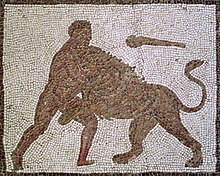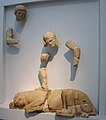Nemean lion

The Nemean lion (/nɪˈmiːən/; Greek: Νεμέος λέων, translit. Neméos léōn;[1] Latin: Leo Nemeaeus) was a monster in Greek mythology that lived at Nemea. Eventually, it was killed by Heracles (Hercules). Because its golden fur was impervious to attack, it could not be killed with mortals' weapons. Its claws were sharper than mortals' swords and could cut through any strong armour. In Bibliotheca, Photius wrote that the dragon Ladon, who guarded the golden apples, was his brother.[2]
Parents[edit]
Hesiod has the Nemean lion as the offspring of Orthus and an ambiguous "she", often understood as probably referring to the Chimera, or possibly to Echidna or even Ceto.[3] According to Hesiod, the lion was raised by Hera and sent to terrorise the hills of Nemea.[4] According to Apollodorus,[5] he was the offspring of Typhon. In another tradition, told by Aelian (citing Epimenides) and Hyginus, the lion was "sprung from" the moon-goddess Selene, who threw him from the Moon at Hera's request.[6]
First labour of Heracles[edit]

The first of Heracles' twelve labours, set by King Eurystheus (his cousin), was to slay the Nemean lion.
Heracles wandered the area until he came to the town of Cleonae. There, he met a boy who said that if Heracles slew the Nemean lion and returned alive within 30 days, the town would sacrifice a lion to Zeus; if he did not return within 30 days or he died, the boy would sacrifice himself to Zeus.[5] Another version claims that he met Molorchos, a shepherd who had lost his son to the lion, saying that if he came back within 30 days, a ram would be sacrificed to Zeus. If he did not return within 30 days, it would be sacrificed to the dead Heracles as a mourning offering.
While searching for the lion, Heracles fetched some arrows to use against it, not knowing that its golden fur was impenetrable; when he found the lion and shot at it with his bow, he discovered the fur's protective property when the arrow bounced harmlessly off the creature's thigh. After some time, Heracles made the lion return to his cave. The cave had two entrances, one of which Heracles blocked; he then entered the other. In those dark and close quarters, Heracles stunned the beast with his club. He eventually killed it by strangling it with his bare hands.
After slaying the lion, he tried to skin it with a knife from his belt, but failed. He then tried sharpening the knife with a stone and even tried with the stone itself. Finally, Athena, noticing the hero's plight, told Heracles to use one of the lion's own claws to skin the pelt.
When Heracles returned on the thirtieth day carrying the carcass of the lion on his shoulders, King Eurystheus was amazed and terrified. Eurystheus forbade him ever again to enter the city; in the future, he was to display the fruits of his labours outside the city gates. Eurystheus warned him that the tasks set for him would become increasingly difficult. He then sent Heracles off to complete his next quest, which was to destroy the Lernaean Hydra.
Heracles wore the Nemean lion's coat after killing it, as it was impervious to the elements and all but the most powerful weapons. Others say that Heracles' armour was, in fact, the hide of the Lion of Cithaeron.
According to Alexander of Myndus, Heracles was helped in this labour by an Earth-born serpent, which followed him to Thebes and settled down in Aulis. It was later identified as the water snake which devoured the sparrows and was turned into stone in the prophecy about the Trojan War.[7]
In art[edit]
-
Gandhara, India, 1st century
-
Renaissance plaque by Galeazzo Mondella
-
Painting by Francisco de Zurbarán (1634)
-
Marble by J.M. Félix Magdalena (b. 1941)
-
Temple of Zeus at Olympia metope 1
See also[edit]
- History of lions in Europe
- List of mythological lions
- Lion of Cithaeron
- Kangla Sha
- Nongshaba
- Tsavo Man-Eaters
- Mfuwe man-eating lion
- Panthera spelaea
- Smilodon
Notes[edit]
- ^ Apollodorus. Mythographi Graeci. Volumen I (in Greek). Рипол Классик. ISBN 978-5-87455-463-7.
- ^ "Bibliothèque de Photius : 190. Ptolémée Chennus, Nouvelle Histoire". remacle.org. Retrieved 6 September 2023.
- ^ The referent of "she" at Hesiod, Theogony 326 is uncertain, see Clay, pp. 159–160, with n. 34; Most, p. 29 n. 20 ("Probably Chimaera"); Hard, p. 63 ("Chimaira (or conceivably with his mother Echidna)"); Gantz, p. 23 ("[Chimera] ... or just possibly Echidna"); Caldwell, p. 47 lines 326 ("either Echidna or Chimaira"); West 1966, p. 356 line 326 ἡ δ' ἄρα ("much more likely ... Chimaera" than Echidna).
- ^ Hesiod, Theogony 327–329
- ^ a b Apollodorus, 2.5.1
- ^ Hard, p. 256; Aelian, 12.7; Hyginus, Fabulae 30
- ^ Daniel Ogden, Drakon: Dragon Myth and Serpent Cult in the Greek and Roman Worlds
- ^ "Archived copy". Archived from the original on 29 July 2017. Retrieved 30 July 2017.
{{cite web}}: CS1 maint: archived copy as title (link)
References[edit]
- Caldwell, Richard (1 June 1987). Hesiod's Theogony. Focus Publishing/R. Pullins Company. ISBN 978-0-941051-00-2.
- Clay, Jenny Strauss (2003). Hesiod's Cosmos. Cambridge University Press. ISBN 978-0-521-82392-0.
- Gantz, Timothy (1993). Early Greek Myth: A Guide to Literary and Artistic Sources. Johns Hopkins University Press. pp. 383–384. ISBN 0-8018-4410-X.
- Hard, Robin (2004). The Routledge Handbook of Greek Mythology: Based on H.J. Rose's "Handbook of Greek Mythology". Psychology Press. ISBN 9780415186360.
- Hesiod, Theogony, in Hesiod, Theogony, Works and Days, Testimonia, Edited and translated by Glenn W. Most. Loeb Classical Library No. 57. Cambridge, Massachusetts, Harvard University Press, 2018. ISBN 978-0-674-99720-2. Online version at Harvard University Press.
- Most, G.W., Hesiod, Theogony, Works and Days, Testimonia, Edited and translated by Glenn W. Most, Loeb Classical Library No. 57, Cambridge, Massachusetts, Harvard University Press, 2018. ISBN 978-0-674-99720-2. Online version at Harvard University Press.
- Smith, William (1873). Dictionary of Greek and Roman Biography and Mythology. London.
{{cite book}}: CS1 maint: location missing publisher (link) - West, M. L. Hesiod: Theogony. Oxford University Press.
See also[edit]
External links[edit]
 Media related to Nemean Lion at Wikimedia Commons
Media related to Nemean Lion at Wikimedia Commons




![Herakles fighting the Nemean lion, Mathura art, India.[8][failed verification]](http://upload.wikimedia.org/wikipedia/commons/thumb/d/d1/Mathura_statue_of_Herakles_strangling_the_Nemaean_lion.jpg/76px-Mathura_statue_of_Herakles_strangling_the_Nemaean_lion.jpg)




